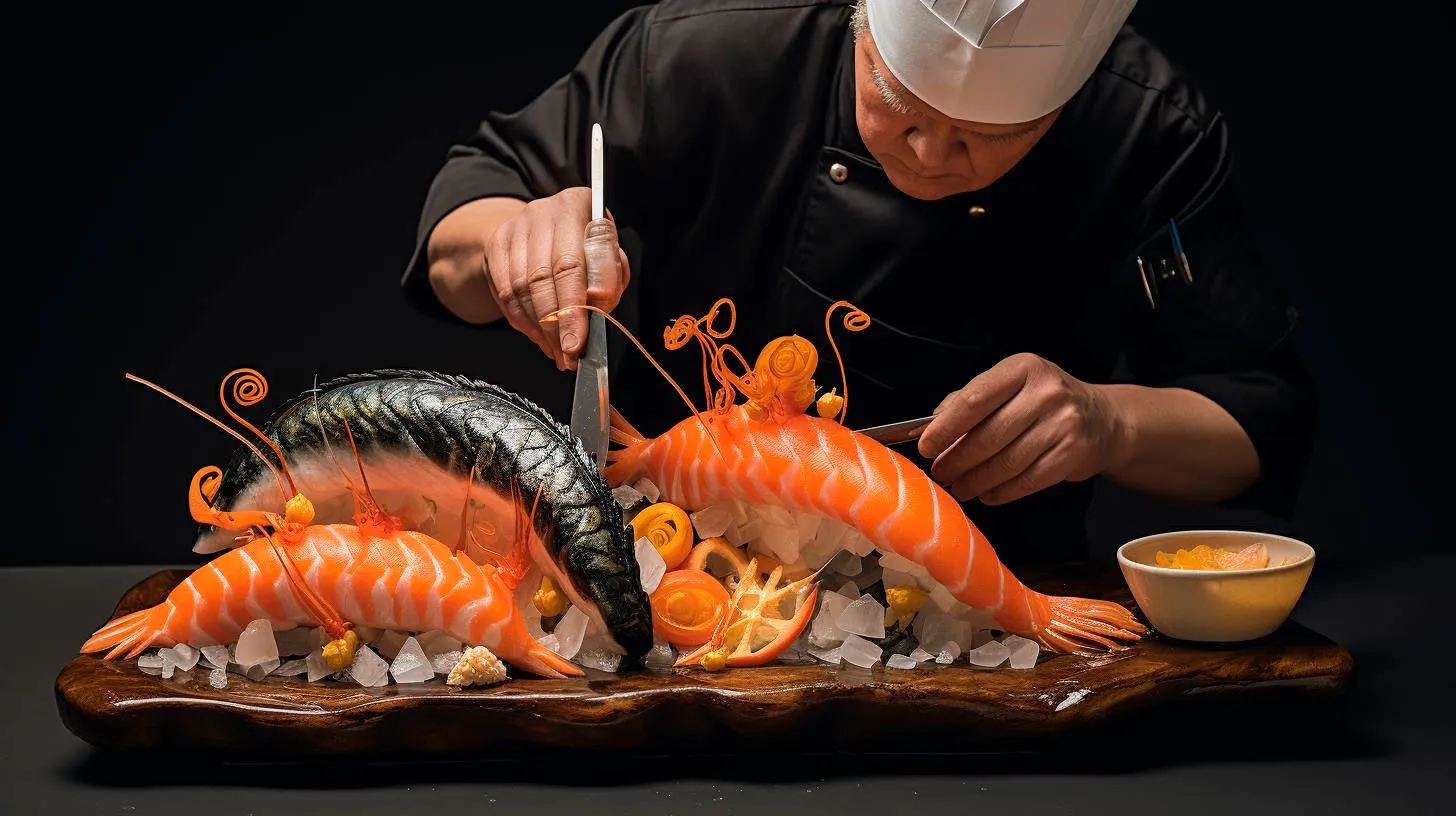Common Mistakes to Avoid When Making Sushi Rolls
Without proper guidance, you may find yourself making some common mistakes that can affect the taste and presentation of your rolls. In this article, we will highlight some of these mistakes and provide you with valuable tips to avoid them.
1. Using Incorrect Rice
One of the most crucial aspects of sushi rolls is the rice. Using the wrong type of rice or improperly preparing it can make or break your sushi. When making sushi rolls, it is recommended to use short-grain sushi rice. This type of rice has a sticky texture, which helps the rolls hold their shape. Avoid using long-grain rice or regular rice varieties, as they will not provide the desired result.
Key Takeaway: Use short-grain sushi rice for the perfect texture and stickiness in your rolls.
2. Overstuffing the Rolls
While it can be tempting to fill your sushi rolls with a myriad of ingredients, overstuffing them can lead to a disastrous outcome. When you overload the rolls with too much filling, it becomes challenging to roll them tightly, resulting in sushi rolls that fall apart or have an unappetizing appearance. Additionally, overstuffing can affect the balance of flavors, making it difficult to enjoy the distinct taste of each ingredient.
Key Takeaway: Opt for a balanced amount of filling to ensure easy rolling and a harmonious flavor profile.
3. Ignoring the Nori Technique
The nori, or seaweed wrapper, is a critical component of sushi rolls. Neglecting the proper technique for handling nori can often lead to rolls that lack structural integrity. It is important to lightly toast the nori before using it, as this helps to enhance its flavor and crispness. Additionally, use a bamboo sushi mat to roll the ingredients tightly, ensuring that the nori holds everything together.
Key Takeaway: Toast the nori and roll tightly using a bamboo sushi mat for well-constructed rolls.
4. Poor Knife Skills
The presentation of your sushi rolls greatly depends on your knife skills. A common mistake is using a dull knife or not using the correct technique to cut the rolls. Remember to keep your knife sharp to achieve clean and precise cuts. Dip the knife in water before each cut to prevent sticking and tearing of the roll. By doing so, you’ll achieve beautifully sliced sushi rolls that are visually appealing.
Key Takeaway: Keep your knife sharp and moisten it before each cut for clean and professional-looking sushi rolls.
5. Inadequate Rolling Technique
Rolling sushi correctly requires practice and technique. A mistake often made by beginners is applying excessive pressure while rolling, resulting in tightly packed, hard rolls. Apply gentle and even pressure throughout the rolling process to achieve a well-formed sushi roll with a soft texture. Remember to keep the rolls tight while rolling, but not to the point where it compromises the delicate balance of fillings.
Key Takeaway: Apply gentle, even pressure while rolling for a perfectly formed and delicately textured sushi roll.
6. Not Dipping Your Fingers in Vinegar Water
When handling sushi rice, it is important to keep your fingers moist to prevent sticking. Many beginners overlook the step of dipping their fingers in vinegar water before handling the rice. By doing this, you prevent the rice from sticking to your fingers and maintain a clean presentation in your sushi rolls.
Key Takeaway: Dip your fingers in vinegar water to prevent the rice from sticking, ensuring clean and professional-looking rolls.
7. Lacking Fresh and High-Quality Ingredients
Sushi is all about fresh and high-quality ingredients. Using stale or low-grade fillings can greatly impact the flavor and overall experience of your sushi rolls. Investing in fresh seafood, vegetables, and other ingredients will elevate the taste and quality of your rolls. Additionally, make sure to use the appropriate condiments such as wasabi and soy sauce to enhance the flavors.
Key Takeaway: Always prioritize fresh and high-quality ingredients to create delectable and authentic sushi rolls.
Conclusion:
By avoiding these common mistakes, you can create sushi rolls that are both visually appealing and delectably flavorful. Remember to use the proper rice, balance your fillings, handle the nori correctly, and refine your knife skills. Additionally, be mindful of your rolling technique, keep your fingers moist, and use only the best ingredients. With practice and attention to detail, you’ll soon be rolling sushi like a pro and impressing your friends and family with your homemade culinary creations.
Step-by-Step Sushi Rolling Guide: Master the Art of Creating Delicious Sushi at Home
The Art of Sushi Rolling
Sushi rolling, also known as maki sushi, is a traditional Japanese culinary technique that combines perfectly seasoned sushi rice with a variety of ingredients, all wrapped in a sheet of nori, a dried seaweed. The result is a beautiful, bite-sized roll that bursts with flavors and textures.
Before we dive into the step-by-step guide, let’s take a moment to appreciate the many advantages of making sushi at home:
- Cost-effective: Creating your own sushi saves you money compared to dining out at sushi restaurants.
- Customizable: You have the freedom to experiment with different fillings and create sushi rolls tailored to your taste preferences.
- Healthy choices: By making sushi at home, you have control over the quality and freshness of the ingredients, allowing you to prioritize health and dietary requirements.
- Creative outlet: Rolling sushi is an art form itself. You can show off your creativity and culinary skills by presenting beautifully rolled sushi to your friends and family.
Step-by-Step Guide to Sushi Rolling
Step 1: Prepare the Ingredients
Gather the essential ingredients needed for sushi rolling:
- Sushi rice
- Nori sheets
- Fillings (e.g., fresh fish, vegetables, avocado, crab, etc.)
- Soy sauce
- Wasabi
- Pickled ginger
Ensure that your ingredients are fresh and of high quality. This will enhance the taste and overall experience of your sushi rolls.
Step 2: Prepare the Sushi Rice
Properly cooked sushi rice is the foundation of every good sushi roll. Follow these steps to prepare sushi rice:
- Rinse the rice under cold water until the water runs clear.
- Cook the rice according to the package instructions.
- In a small bowl, mix rice vinegar, sugar, and salt until the sugar dissolves.
- While the rice is still warm, gently fold in the vinegar mixture with a wooden spatula.
Allow the rice to cool to room temperature before using it for sushi rolling.
Step 3: Get Rolling!
Now that your ingredients are ready, let the rolling begin:
- Place a bamboo sushi rolling mat on a flat surface.
- Place a sheet of nori on the bamboo mat.
- Moisten your hands with water to prevent sticking and grab a handful of sushi rice.
- Spread the rice evenly over the nori, leaving a small gap at the top.
- Arrange your desired fillings in a neat line across the center of the rice.
- Using the bamboo mat, start rolling the sushi from the bottom, applying gentle pressure to keep it tight.
- Moisten the top edge of the nori with water to seal the roll.
- Continue rolling until the entire roll is complete.
- Repeat the process with other ingredients and variations.
Remember, practice makes perfect! Don’t worry if your first sushi roll isn’t flawless. With each attempt, your rolling skills will improve.
Key Takeaways
Now that you’ve learned the art of sushi rolling, it’s time to enjoy the fruits of your labor. Here are some key takeaways to remember:
- Homemade sushi allows for customization, cost savings, and healthier choices.
- Quality ingredients are crucial for a flavorful sushi experience.
- Master the art of cooking sushi rice for a perfect foundation.
- Practice rolling techniques to achieve beautiful sushi rolls.
So, the next time you’re craving sushi, don’t hesitate to unleash your inner sushi chef and create your own delicious rolls at home. With this step-by-step sushi rolling guide, you’ll soon be impressing your friends and family with your sushi-making skills.
Exploring Different Fillings and Flavors: Unleashing the Delightful World of Food!
Join us on a mouth-watering journey as we explore the diverse fillings and flavors that make our meals unforgettable.
1. Sweet and Savory Fillings: A Match Made in Heaven
The combination of sweet and savory fillings in various dishes has been a culinary tradition for centuries. This unique pairing creates a harmony on our palate that keeps us hooked. Imagine biting into a warm, buttery croissant filled with creamy almond paste or indulging in a hearty bowl of chicken pot pie oozing with savory broth and succulent meat.
Key Takeaway: Experimenting with sweet and savory fillings adds depth and complexity to your dishes, enticing your taste buds with every bite.
2. Exotic Fillings: A Global Gastronomic Adventure
Embark on a global gastronomic adventure by exploring exotic fillings that hail from various corners of the world. Travel to India with buttery samosas filled with spiced potatoes and peas, or savor the rich flavors of Mexico with tantalizing empanadas filled with seasoned ground meat and melted cheese. The world is your oyster when it comes to exploring diverse fillings and flavors.
Key Takeaway: Trying out exotic fillings opens up a whole new world of flavors and expands your culinary horizons.
3. The Power of Cheese Fillings: Melting Hearts, One Bite at a Time
When it comes to indulgence, cheese fillings have a special place in our hearts. They add a creamy, gooey, and irresistible element to various dishes. Whether it’s a classic mac and cheese with its silky cheese-filled sauce or a sumptuous grilled cheese sandwich oozing with melted goodness, cheese is a filling that never fails to satisfy.
Key Takeaway: Cheese fillings can elevate any dish, turning it into a comforting and indulgent experience that leaves you craving for more.
4. Filling Alternatives for Dietary Preferences
Food should be inclusive, catering to various dietary preferences and restrictions. Thankfully, there is an abundance of filling alternatives available today. For those following a plant-based diet, fillings such as marinated tofu or hearty vegetables like mushrooms provide endless possibilities. Gluten-free options like quinoa or cauliflower are perfect alternatives for those with sensitivities or allergies. By exploring these alternatives, we can create inclusive and delicious meals for everyone to enjoy.
Key Takeaway: Embracing filling alternatives allows us to cater to a wider audience and ensures that no one misses out on delectable flavors.
5. Balancing Flavors: The Art of the Perfect Filling
Mastering the art of balancing flavors is crucial when creating memorable fillings. Acidity, sweetness, bitterness, and umami must harmonize to create a symphony on our taste buds. Adding a burst of tang with a squeeze of lemon or a sprinkle of sea salt can elevate a filling from good to exceptional. Don’t shy away from experimenting with different combinations to find the perfect balance.
Key Takeaway: Balancing flavors in fillings is the key to creating unforgettable culinary experiences that leave a lasting impression.
Conclusion
In the mesmerizing world of flavors and fillings, the possibilities are endless. By exploring different fillings, we unlock the true potential of our meals, infusing them with excitement and creativity. From sweet and savory combinations to indulgent cheeses and exotic flavors, our taste buds are in for an unforgettable adventure. So get ready to embark on a culinary journey, where every bite showcases the diversity and passion that exists in our world of food.



